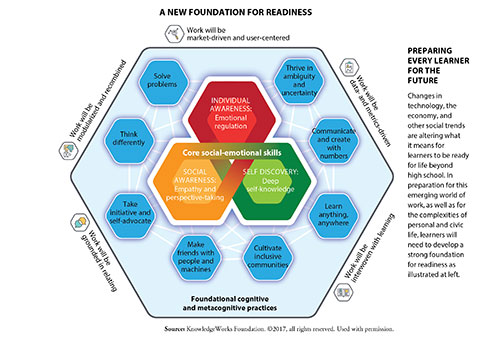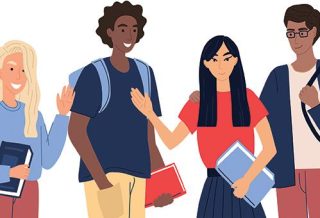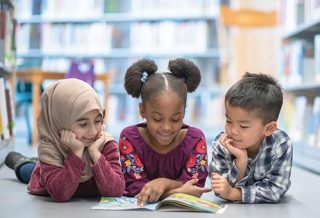FOCUS
Make the most of the momentum
Let's prepare educators to harness personalized learning's potential
By Rebecca E. Wolfe and Lillian Pace
Categories: College- and career-ready standards, Personalization, Reaching all studentsAugust 2019
Vol. 40 No. 4
On any given school day, the majority of students in the United States and many other countries experience the same kind of schooling as their parents — and even their parents’ parents. And yet, today’s students live in a world that looks vastly different. The voices demanding that we move our education system far beyond its 20th-century roots grow louder every year.
Educators, parents, employers, and advocates in all corners of the education world are calling out the ways in which our prevailing systems devalue educators’ professionalism, sort and batch children according to their skin color and ZIP code, and turn the joy of learning into marching lockstep through tests and worksheets.
A promising antidote to this grim outlook has risen in the past 10 years in the form of personalized learning approaches. At its most basic, personalized learning is “driven by good teaching and strong student supports centered on the needs of each student” (Ambrose, 2019). What’s behind that statement is a vision of teaching and learning that goes far beyond traditional instruction and calls into question how we prepare educators to lead those changes.
The movement for personalized learning is grounded in three driving forces:
- Changes in technology, our economy, and other social trends are altering what it means for learners to be ready for life beyond high school.
- Insights from the learning sciences have busted the myth of the “average learner” and underscored the unique strengths, challenges, contexts, and needs of each learner.
- We need to make far greater gains in closing opportunity gaps and ensuring that we meet the needs of all youth, especially our most vulnerable youth, and help them develop to their full potential.
The potential of personalized learning to meet learners’ needs, close opportunity gaps, and prepare them to craft their own futures was a focus in KnowledgeWorks’ 2006-16 Map of Future Forces Affecting Education (KnowledgeWorks, 2006) and all of its subsequent forecasts on the future of learning (e.g. Prince, Swanson, King, & Saveri, 2018).
After more than 10 years of reflecting on the current state and emerging trends in teaching and learning, the team at KnowledgeWorks recognizes that personalized learning is gathering momentum, and that educators and those who support them need the knowledge and capacity to realize its benefits.
The educator’s role
There is no shortage of hype around personalized learning, including lack of clear definition and disparate ideas about what it should look like. At KnowledgeWorks, we use the term personalized learning to refer to educational systems and approaches that are rooted in the equitable belief that all children can learn, are student-centered, and involve whole-child supports.
What is new in today’s personalized learning approaches is putting equity in the foreground of the system. What is new in today’s personalized learning approaches is putting equity in the foreground of the system. #LearnFwdTLP Learn more: Share on X
In this definition, personalized learning is a systemic approach and not interchangeable with technology. Technology is additive and supportive of great teaching and learning. In this vision, as a result of having engaged in high-quality, relationship-based personalized learning experiences, every child will emerge from his or her education experience with self-confidence, independence, and solid preparation for whatever unique path awaits. As a result of having engaged in HQ, relationship-based personalized learning experiences, every child will emerge from his or her edu experience w/ self-confidence, independence, & solid preparation for their future. Share on X
Many of the principles of personalized learning simply reflect good teaching and learning practices. However, for a setting to be personalized, some of these practices — such as connections to meaningful work — take on greater import.
There have been several attempts in the past decade to better describe, codify, and support how the role of the educator shifts in a modern personalized learning approach. One of the earliest of these was the Teachers at Work research released as part of JFF’s (formerly Jobs for the Future) Students at the Center initiative (Cervone & Cushman, 2012). Cervone and Cushman spent time in six early adopter schools pursuing student-centered approaches and captured eight core elements of personalized teaching:
- Strong relationships with students;
- Anytime, anywhere, and real-world learning;
- Personalization and choice in curricular tasks;
- Technology that is integral to teaching and learning;
- Appropriate challenge levels for each learner;
- Clear, timely assessment and support;
- Supporting social and emotional growth; and
- Fostering autonomy and lifelong learning.
Since then, many studies and reports have reinforced this list (e.g. Levitzky, Merin, Murphy, & Klemm, 2017; Jobs for the Future & CCSSO, 2015; Jenkins, Williams, Moyer, George, & Foster, 2016). Across this work, a key emerging insight is that teaching in personalized learning settings is distinguished by profound changes in relationships. Teaching in personalized learning settings is distinguished by profound changes in relationships. #LearnFwdTLP Share on X
Relationships between student and teacher shift from teacher as holder of knowledge and student as vessel to be filled to students as active seekers of mastery facilitated by teachers as learning partners. Relationships among teaching peers move from isolated planning days complemented by lunchroom venting to frequent collaboration characterized by deep attention to improving student learning and engagement.
Administrators spend less time evaluating and remediating staff and more time on building a culture of trusting relationships, setting conditions for risk-taking, and supporting teachers to lead and learn. Educators’ and students’ relationships with curriculum and assessments focus on interest, passion, inquiry, connection, and authentic demonstrations of learning to meet high standards instead of rote regurgitation of facts and formulas.
At a more granular level, there have been several attempts to define, codify, and provide indicators of standards and competencies of teaching in a personalized manner. Educator Competencies for Personalized, Learner-Centered Teaching, produced by the Council of Chief State School Officers (CCSSO) and JFF’s Students at the Center, is a comprehensive document that compiled research on high-quality teaching and learning sciences and cross-walked competencies from 12 existing educator frameworks spanning a continuum from traditional to fully personalized instruction.
The two organizations then worked with close to 100 state agency, district, school, and supporting educators and researchers to home in on what an educator’s skills, knowledge, and dispositions would look like in personalized, student-centered settings (Jobs for the Future & CCSSO, 2015).
The document and accompanying online tool identified four major domains of personalized educators: intrapersonal (need to process), interpersonal (need to relate), cognitive (need to know), and instructional (need to do). CCSSO is leading a coalition of nonprofits and associations to streamline and strengthen educator pipelines, including refreshing CCSSO’s InTASC Model Core Teaching Standards for effective practice (CCSSO, 2011) with a closer eye to culturally competent, student-centered competencies that align with the educator competencies.
No one claims shifting to personalizing learning is quick or easy. And most who advocate for personalized approaches for students recognize the irony of subjecting educators to nonengaging, traditional, one-offs as a way to learn to personalize for students. As a result, numerous organizations have developed means to help educators not only teach in personalized ways, but also experience personalized professional development. No one claims shifting to personalizing learning is quick or easy. However, there are numerous organizations who have developed means to help educators not only teach in personalized ways, but also experience personalized PD. Share on X
Here are some examples: Fuse RI, run by the Highlander Institute, is a teachers-helping-teachers fellowship that places active educators to coach other schools as they explore personalized methods. The Institute for Personalized Learning runs mixed modality professional learning workshops and coaching in Wisconsin. Next Generation Learning Challenges supports school networks using design thinking methods.
The LearnNext multiorganization initiative led by 2Revolutions provides open source courseware and learning progressions for educators. KnowledgeWorks partners at the district and state levels to help systems and schools move toward personalized, competency-based learning transformation.
The Role of Policy
Growing interest in personalized learning has sparked significant policy change over the past decade, and those policies have implications for educator preparation and support. Federal, state, and local policymakers are championing reforms that range from pilot initiatives to statewide conversations about how to redesign the education system to support personalized learning for all students.
Thirty-five states have established an innovation or pilot program to empower local educators interested in personalized teaching and learning models (ExcelinEd & Foresight Law+Policy, 2019), and 39 states have leveraged new flexibility granted by the federal Every Student Succeeds Act (ESSA) to embed personalized learning policies in their state plans (KnowledgeWorks, 2018).
These policy changes will require a new approach to instruction that empowers educators to meet all students’ needs and design rigorous and innovative learning pathways that align to students’ interests and career aspirations.
The U.S. has yet to see a state fully align its policy system to support a statewide shift that includes building educator capacity for personalized learning, but a handful of states are already leading this charge. For example, in 2019, South Carolina’s Office of Personalized Learning held its first statewide professional development conference, North Dakota kicked off quarterly convenings with district design teams focused on personalized, competency-based education, and Idaho launched the Idaho Mastery Education Network with a dedicated appropriation of $1.4 million.
As the movement grows, states will need to reexamine policies that support educators and leaders to intentionally align preservice, credentialing, professional learning, and evaluation systems to ensure educators have the skills to succeed in personalized learning environments. Equally important, states should ensure that educators benefit from the same level of personalization as their students.
Following the lead of the organizations and efforts mentioned above, states need to ensure educators and leaders have the resources and flexibility to master their own competencies and progress to deeper levels of expertise throughout their career.
Implications for professional learning
Pulling these practice shifts and supports and policy trends together, the following are important implications for professional learning and leading:
- Professional learning for adults should mirror the principles of personalization that we are espousing for our students.
- Educators should leverage technology to maximize impact, not to replace strong teaching and learning.
- Higher education and policy need to support educators to keep pace with changes in learning approaches.
- We should look through a research lens to determine if personalized learning is achieveing its goals. If not, why not? Is it the instructional design or its implementation?
- Equity must drive the work.
Personalized learning approaches are inherently designed to ensure all students get what they need, when they need it, to reach their highest potential. But good intentions aren’t enough. Every decision in schools, from assessment to discipline and everything in between, needs to be viewed through the lens of, “Will this enhance equity and close opportunity gaps?” Administrators, teachers, and students need to support each other in making that question a regular and frequent occurrence. Every decision in schools, from assessment to discipline and everything in between, needs to be viewed through the lens of, “Will this enhance equity and close opportunity gaps?” #LearnFwdTLP Share on X
The concept that learners should be at the center of teaching is not new. What is new in today’s personalized learning approaches is putting equity in the foreground of the system. All teachers and students should be partners in the transformation of learning, and supporting educators to make that shift is a responsibility we all share. The concept that learners should be at the center of teaching is not new. What is new in today’s personalized learning approaches is putting equity in the foreground of the system. #LearnFwdTLP Share on X
References
Ambrose, C. (2019). Personalized learning isn’t about technology. It’s about giving every student an opportunity to learn. Available at knowledgeworks.org/resources/personalized-learning-technology-students.
Cervone, B. & Cushman, K. (2012). Teachers at work: Six exemplars of everyday practice. Boston, MA: Jobs for the Future.
Council of Chief State School Officers. (2011, April). InTASC Model Core Teaching Standards. Washington, DC: Author.
ExcelinEd & Foresight Law+Policy. (2019). State progress toward next generation learning: A national landscape. Tallahassee, FL: ExcelinEd.
Jenkins, S., Williams, M., Moyer, J., George, M., & Foster, E. (2016). The shifting paradigm of power: Personalized learning according to teachers. Available at knowledgeworks.org/wp-content/uploads/2018/01/teacher-conditions.pdf.
Jobs for the Future & Council for Chief State School Officers. (2015, August). Educator competencies for personalized, learner-centered teaching. Available at studentsatthecenterhub.org/wp-content/uploads/2015/12/EducatorCompetencies_081015.pdf.
KnowledgeWorks. (2018). ESSA personalized learning dashboard. Available at knowledgeworks.org/resources/essa-personalized-learning-dashboard.
KnowledgeWorks. (2006). 2006-16 map of future forces affecting education. Available at knowledgeworks.org/resources/map-future-forces.
Levitzky, D., Merin, M., Murphy E., & Klemm, K. (2017). Mapping mastery: Building educator capacity for personalized learning. Available at www1.headwaycloud.com/clients/91/uploaded_files/mappingmastery_naate.pdf.
Prince, K., Swanson J., King, K., & Saveri, A. (2018). Forecast 5.0 – The future of learning: Navigating the future of learning. Available at knowledgeworks.org/resources/forecast-5.
Categories: College- and career-ready standards, Personalization, Reaching all students
Recent Issues
BUILDING BRIDGES
December 2024
Students benefit when educators bridge the continuum of professional...
CURRICULUM-BASED PROFESSIONAL LEARNING
October 2024
High-quality curriculum requires skilled educators to put it into...
LEARNING TO PIVOT
August 2024
Sometimes new information and situations call for major change. This issue...
GLOBAL PERSPECTIVES
June 2024
What does professional learning look like around the world? This issue...













